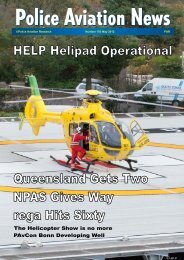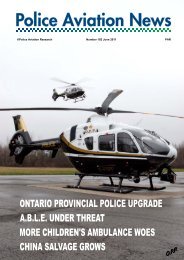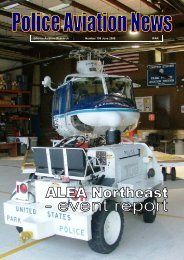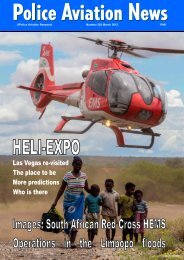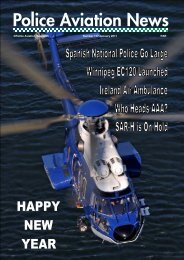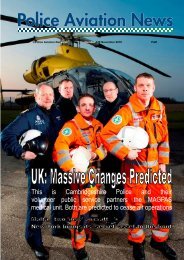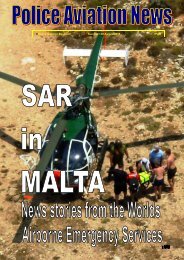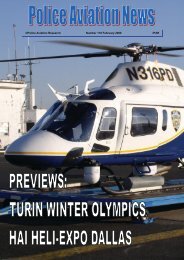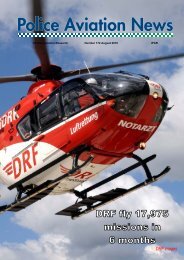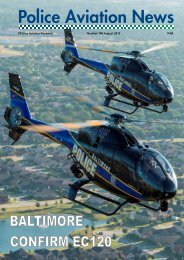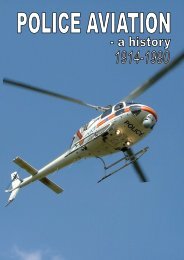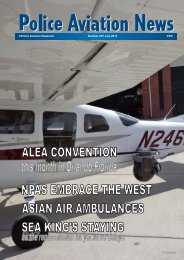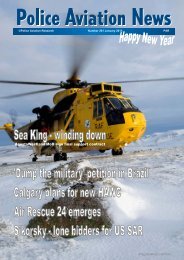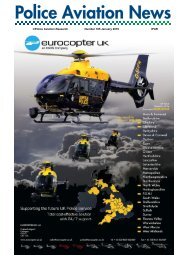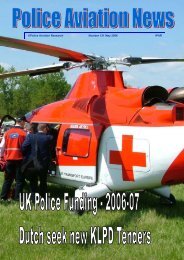Police Aviation News November 2008
Police Aviation News November 2008
Police Aviation News November 2008
You also want an ePaper? Increase the reach of your titles
YUMPU automatically turns print PDFs into web optimized ePapers that Google loves.
<strong>Police</strong> <strong>Aviation</strong> <strong>News</strong> <strong>November</strong> <strong>2008</strong> 26<br />
enforcement, air medical, firefighting, news gathering and utility missions. Canadian and<br />
European approvals are in process for the EC130, extending the AFS solution for AS350B3<br />
dual hydraulic and EC130 operators worldwide.<br />
The AFS system features a sealed intake plenum that replaces the inlet screens, sand filter/<br />
particle separator or alternate barrier filter. Design of the IBF utilizes the existing cowl with<br />
minimum modification, including incorporation of an aft-facing bypass system. The filter and<br />
bypass system are flush with the upper surface of the EC130 or B3 dual hydraulic cowling,<br />
utilising an internal bypass plenum. By incorporating deep pleats, AFS technology allowed<br />
the filter footprint to be limited to the upper surface of the cowling and still accommodate the<br />
bypass. An emergency bypass capability is an important IBF feature that is lacking in most<br />
traditional sand filters and particle separators.<br />
A simple compact cockpit switch, common with existing AFS certified systems, allows indication<br />
and activation of the bypass system. An integral Filter Maintenance Aid allows for oncondition<br />
inspections between established cleaning intervals, eliminating unnecessary service.<br />
AFS AS350/EC130 IBF-equipped aircraft can also operate with no inlet driven flight or<br />
gross weight restrictions to the basic inlet performance charts, with the option to also operate<br />
to the sand filter performance charts when required. www.afsfilters.com<br />
ACCIDENTS & INCIDENTS<br />
5 September <strong>2008</strong> Bell 407 N911WN. Air ambulance of Air Link of Scottsbluff, Nebraska<br />
operated by Air Methods. Suffered a bird strike whilst flying from Regional West in<br />
Nebraska To PSL in Denver with a patient on board. A noise was heard at the time but no<br />
damage or problems highlighted. The next day, a spot of blood and feathers were found on<br />
the front left of the helicopter. No damage found. [Concern]<br />
24 September <strong>2008</strong> Eurocopter EC135 N135ED. Air ambulance of Carilion Clinic Life<br />
Guard out of Roanoke Virginia USA operated by Air Methods. The aircraft was en route<br />
from Roanoke to the Christiansburg, Virginia base of Life-Guard 11. While en route, a<br />
Transmission Chip Light illuminated. The fuzz burn procedure was completed successfully.<br />
The light illuminated a second time, and the fuzz burn procedure was again utilized, without<br />
success. The decision was made to make a precautionary landing. Aircraft landed without<br />
further incident in a church car park. A mechanic attended and after some work the aircraft<br />
was flown out. [Concern]<br />
27 September <strong>2008</strong> Sikorsky S76 N370GS. Air ambulance of Good Samaritan Air-<br />
Care of Kearney, Nebraska operated by Rodgers Helicopter Service. While transitioning<br />
south of the local airport on approach to the base hospital, a signaling flare was shot from<br />
the ground towards the aircraft. The flare passed in front of the helicopter but did not appear<br />
to make contact with the ship or rotor disc. The helicopter was inspected by the PIC<br />
and ground safety personnel and no damage was noted. [Concern]<br />
30 September <strong>2008</strong> Eurocopter BK117B2 C-FIOM. Air ambulance of STARS Air<br />
Rescue, Calgary, Alberta, Canada. The aircraft was enroute from Peace River, Alberta to<br />
the QE II hospital in Grande Prairie, Alberta with a patient on board. Approximately 20 NM<br />
north of Grande Prairie, the Master Caution Light illuminated along with the #1 Engine Chip<br />
Caution Panel Segment. Checklist procedures were carried out and the engine was shut<br />
down. An emergency was declared. The aircraft diverted to Grande Prairie Airport to carry<br />
out a precautionary single engine landing without further incident. Upon investigation a very<br />
small metallic chip was found on the #1 engine scavenge debris monitor. [Concern]<br />
2 October <strong>2008</strong> Eurocopter AS350B32 N172AE. Department of Homeland Security.<br />
Whilst undertaking training suffered severe damage in a hard landing at Blaine, Washington.<br />
[FAA]



